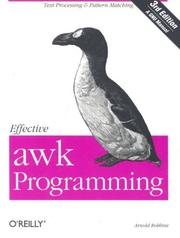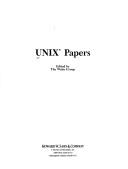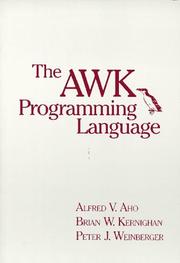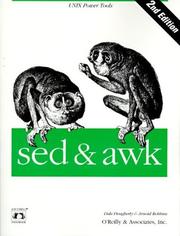| Listing 1 - 10 of 10 |
Sort by
|

ISBN: 0596000707 Year: 2001 Publisher: Beijing ; Cambridge, Mass. : O'Reilly,
Abstract | Keywords | Export | Availability | Bookmark
 Loading...
Loading...Choose an application
- Reference Manager
- EndNote
- RefWorks (Direct export to RefWorks)
Book
Year: 2018 Publisher: Birmingham ; Mumbai : Packt,
Abstract | Keywords | Export | Availability | Bookmark
 Loading...
Loading...Choose an application
- Reference Manager
- EndNote
- RefWorks (Direct export to RefWorks)
Text processing and pattern matching simplified About This Book Master the fastest and most elegant big data munging language Implement text processing and pattern matching using the advanced features of AWK and GAWK Implement debugging and inter-process communication using GAWK Who This Book Is For This book is for developers or analysts who are inclined to learn how to do text processing and data extraction in a Unix-like environment. Basic understanding of Linux operating system and shell scripting will help you to get the most out of the book. What You Will Learn Create and use different expressions and control flow statements in AWK Use Regular Expressions with AWK for effective text-processing Use built-in and user-defined variables to write AWK programs Use redirections in AWK programs and create structured reports Handle non-decimal input, 2-way inter-process communication with Gawk Create small scripts to reformat data to match patterns and process texts In Detail AWK is one of the most primitive and powerful utilities which exists in all Unix and Unix-like distributions. It is used as a command-line utility when performing a basic text-processing operation, and as programming language when dealing with complex text-processing and mining tasks. With this book, you will have the required expertise to practice advanced AWK programming in real-life examples. The book starts off with an introduction to AWK essentials. You will then be introduced to regular expressions, AWK variables and constants, arrays and AWK functions and more. The book then delves deeper into more complex tasks, such as printing formatted output in AWK, control flow statements, GNU's implementation of AWK covering the advanced features of GNU AWK, such as network communication, debugging, and inter-process communication in the GAWK programming language which is not easily possible with AWK. By the end of this book, the reader will have worked on the practical implementation of text processing and pattern matching using AWK to perform routine tasks. Style and approach An easy-to-follow, step by step guide which will help you get to grips with real-world applications of AWK programming.

ISBN: 0672225786 9780672225789 Year: 1987 Publisher: Indianapolis (Ind.): Sams
Abstract | Keywords | Export | Availability | Bookmark
 Loading...
Loading...Choose an application
- Reference Manager
- EndNote
- RefWorks (Direct export to RefWorks)
UNIX (Computer file) --- UNIX (Computer operating system) --- Streams --- C (langage de programmation) --- Ethernet --- Mail --- Awk
Book
ISBN: 1683929713 1683929721 Year: 2022 Publisher: Bloomfield : Mercury Learning & Information,
Abstract | Keywords | Export | Availability | Bookmark
 Loading...
Loading...Choose an application
- Reference Manager
- EndNote
- RefWorks (Direct export to RefWorks)
This book introduces an assortment of powerful command line utilities that can be combined to create simple, yet powerful shell scripts for processing datasets. The code samples and scripts use the bash shell, and typically involve small datasets so you can focus on understanding the features of grep, sed, and awk. Companion files with code are available for downloading from the publisher. FEATURES:Provides the reader with powerful command line utilities that can be combined to create simple yet powerful shell scripts for processing datasetsContains a variety of code fragments and shell scripts for data scientists, data analysts, and those who want shell-based solutions to “clean” various types of datasetsCompanion files with code
Computer Science. --- Data Science. --- Pandas. --- Programming. --- Python. --- UNIX. --- awk. --- data mining. --- grep. --- sed.
Book
ISBN: 1098128281 3969100720 Year: 2020 Publisher: dpunkt,
Abstract | Keywords | Export | Availability | Bookmark
 Loading...
Loading...Choose an application
- Reference Manager
- EndNote
- RefWorks (Direct export to RefWorks)
Computerpionier Brian W. Kernighan war in der Entwicklung von UNIX beteiligt. In diesem lebendig illustrierten Buch erzählt er eine umfassende Geschichte des äußerst einflussreichen und weit verbreiteten Betriebssystems von den Anfängen bis zur heutigen Bedeutung. Kernighan leistete fast von Anfang an aktive Beiträge. Sein persönliches Miterleben der Entwicklung und die persönlichen Anekdoten von seinen damaligen Wegbegleitern verleihen dem Buch einen großen Wert. Kernighan schafft eine gelungene Balance zwischen »offizieller Geschichte« und seinem eigenen Engagement bei der Entwicklung von UNIX. Er erklärt überzeugend, warum gerade UNIX und sein Ökosystem einen Siegeszug in die Server dieser Welt antreten konnten.
Programmierung --- Betriebsysteme --- AT&T Bell Labs --- AWK-Programmiersprache --- Ken Thompson --- Dennis Ritchie
Book
ISBN: 1683929020 1683929039 Year: 2022 Publisher: Bloomfield : Mercury Learning & Information,
Abstract | Keywords | Export | Availability | Bookmark
 Loading...
Loading...Choose an application
- Reference Manager
- EndNote
- RefWorks (Direct export to RefWorks)
"This book contains a fast-paced introduction to as much relevant information about managing data that can be reasonably included in a book of this size. However, you will be exposed to a variety of features of NumpPy and Pandas, how to create databases and tables in MySQL, and how to perform many data cleaning tasks and data wrangling. Some topics are presented in a cursory manner, which is for two main reasons. First, it's important that you be exposed to these concepts. In some cases, you will find topics that might pique your interest, and hence motivate you to learn more about them through self-study; in other cases, you will probably be satisfied with a brief introduction. In other words, you will decide whether or not to delve into more detail regarding the topics in this book. Second, a full treatment of all the topics that are covered in this book would significantly increase the its size of this book, and few people have the time to read technical tomes"--
Computer programming. --- Pandas. --- Java. --- MySQL. --- NumPy. --- Python. --- RDBMs. --- awk. --- computer science. --- data cleaning. --- data science. --- programming.
Book
ISBN: 1683929470 1683929489 Year: 2024 Publisher: Boston, MA : Mercury Learning & Information,
Abstract | Keywords | Export | Availability | Bookmark
 Loading...
Loading...Choose an application
- Reference Manager
- EndNote
- RefWorks (Direct export to RefWorks)
This book is designed for data scientists, machine learning practitioners, and anyone with a foundational understanding of Python 3.x. In the evolving field of data science, the ability to manipulate and understand datasets is crucial. The book offers content for mastering these skills using Python 3. The book provides a fast-paced introduction to a wealth of feature engineering concepts, equipping readers with the knowledge needed to transform raw data into meaningful information. Inside, you’ll find a detailed exploration of various types of data, methodologies for outlier detection using Scikit-Learn, strategies for robust data cleaning, and the intricacies of data wrangling. The book further explores feature selection, detailing methods for handling imbalanced datasets, and gives a practical overview of feature engineering, including scaling and extraction techniques necessary for different machine learning algorithms. It concludes with a treatment of dimensionality reduction, where you’ll navigate through complex concepts like PCA and various reduction techniques, with an emphasis on the powerful Scikit-Learn framework.

ISBN: 020107981X 9780201079814 Year: 1988 Publisher: Reading, Mass.
Abstract | Keywords | Export | Availability | Bookmark
 Loading...
Loading...Choose an application
- Reference Manager
- EndNote
- RefWorks (Direct export to RefWorks)
Programming --- AWK (Computer program language) --- #TELE:SYST --- 681.3*D32 --- Domain-specific programming languages --- language classifications: applicative languages; data-flow languages; design languages; extensible languages; macro and assembly languages; nonprocedural languages; specialized application and very high-level languages (Programminglanguages) --- AWK (Computer program language). --- 681.3*D32 language classifications: applicative languages; data-flow languages; design languages; extensible languages; macro and assembly languages; nonprocedural languages; specialized application and very high-level languages (Programminglanguages) --- Awk (computer program language)

ISBN: 1565922255 9781565922259 Year: 1997 Publisher: Cambridge O'Reilly
Abstract | Keywords | Export | Availability | Bookmark
 Loading...
Loading...Choose an application
- Reference Manager
- EndNote
- RefWorks (Direct export to RefWorks)
Utilities (Computer programs) --- Utilitaires (Logiciels) --- UNIX (Computer file) --- Sed (Computer file) --- Awk. --- AWK (Langage de programmation) --- Editeurs de texte (Logiciels) --- 681.3*D4 --- 005.43 --- Routines, Utility (Computer programs) --- Utility programs (Computer programs) --- Utility routines (Computer programs) --- Computer programs --- Systems software --- Operating systems--See also {681.3*C} --- UNIX (Computer operating system) --- 681.3*D4 Operating systems--See also {681.3*C} --- AWK (Computer program language) --- Text processing (Computer science) --- UNIX (système d'exploitation des ordinateurs) --- AWK (langage de programmation) --- Utilitaires (logiciels) --- Utilities (Computer programs). --- UNIX (Computer file). --- UNIX (système d'exploitation des ordinateurs)
Book
ISBN: 1683928210 1683928229 Year: 2022 Publisher: Bloomfield : Mercury Learning & Information,
Abstract | Keywords | Export | Availability | Bookmark
 Loading...
Loading...Choose an application
- Reference Manager
- EndNote
- RefWorks (Direct export to RefWorks)
"This book contains a fast-paced introduction to as much relevant information about Python tools for data scientists as possible that can be reasonably included in a book of this size. If you are a novice, this book will give you a starting point from which you can decide which Python technologies that you want to explore in greater detail. You will be exposed to features of Numpy and Pandas, how to write regular expressions, and how to perform data cleaning tasks. Some topics are presented in a cursory manner, which is for two main reasons. First, it's important that you be exposed to these concepts. In some cases you will find topics that might pique your interest, and hence motivate you to learn more about them through self-study; in other cases you will probably be satisfied with a brief introduction. In other words, you will decide whether or not to delve into more detail regarding each of the topics in this book"--
Computer programming. --- Electronic data processing. --- Python (Computer program language) --- NumPy. --- Python. --- SciPy. --- Sklearn. --- awk. --- data cleaning. --- data science. --- data visualization. --- programming.
| Listing 1 - 10 of 10 |
Sort by
|

 Search
Search Feedback
Feedback About UniCat
About UniCat  Help
Help News
News